K.4 subsystem: envelope – Retrotec USACE User Manual
Page 394

K6 ENERGY & PROCESS ASSESSMENT PROTOCOL
K.4 Subsystem: Envelope
Figure K4. Example of a heterogeneous and
wide envelope with diverse thickness in an old
building.
Envelopes of old buildings may differ signifi cantly within the same building
according to their geographical areas and their age, as well in their vertical or
horizontal constitution. There is a wide range of materials and forms of con-
struction. Many materials, the majority of them of local geological origin, such
as pieces of wood and cob wall, are used. This diversity generates diffi culties
for the modeling of the thermal characteristics of an envelope (Figure K4).
In the past, masonry was often of stone. Ancient stone structures are very
diverse. Stones were locally extracted because of high costs of transportation.
Bricks are manufactured materials that were initially made of clay. Until
1930, the dimensions of solid bricks were not standardized and varied from
one area to another.
Ancient frames made of pieces of wood were predominant at the end of the
19th century. Frames were used for cross walls and facades facing backward,
and rested on a masonry base in order to keep the frame safe from moisture
coming from the ground. The space between the pieces of wood was fi lled with
a mixture of local materials.
